Jun
02
2020
June 02, 2020

Criminologist Kubrin discusses crime trends during pandemic
Charis Kubrin, professor of criminology, law and society, and Dean Nancy Guerra discussed crime during the coronavirus pandemic during "Parkside Chats," a School of Social Ecology webinar series, highlighting the school's experts on the social, environmental and mental health effects of today's pandemic.
Watch the preview:
The webinar:
5 Takeaways:
- Crime, overall, is down and in some cases, significantly, in major cities across the U.S. (and worldwide). Opportunity largely explains these declines. For property crimes, residential burglary, for example, is much less likely to occur when folks are at home all day. This decline also applies to violent crime as assaults and homicides are decreasing with fewer chances for people to come into contact with each other due to stay-at-home orders. Exceptions to this trend include commercial burglary and auto-theft, as commercial establishments and vehicles are left unattended during the pandemic.
- Other crimes like fraud are rising as would-be offenders shift their efforts to on-line opportunities. We are also witnessing a rise in domestic violence and child abuse that is concerning. And, history tells us pandemics predictably lead to the scapegoating of minorities. With COVID-19, Asians have been increasingly targeted in hate crimes in which they are blamed for causing the virus.
- Despite these general trends, variability is the norm. That is, we see variation in trends across countries. Across states in the U.S. Across U.S. cities. And even across neighborhoods in any given city. Much crime is local.
- The pandemic allows criminologists to consider broader debates in field (e.g., to what extent is crime driven by motivation or opportunity, or some combination of the two) and it offers an unprecedented opportunity to test some key theories in our field to see how they hold up. Among the many important research questions moving forward are: What are the longer term economic impacts of pandemic and how will they affect crime rates?; Gun purchases skyrocketed during the pandemic. What impact, if any, will this have on crime?; How will major changes in the criminal justice system—for example, releasing low-level offenders from jails and prisons due to concerns about spreading the virus—impact crime rates?
- As criminologists tackle these and other critical research questions, they’ll have to keep several things in mind including:
- timing of the impacts (some changes induce a relatively immediate effect (e.g., lockdowns and social distancing) while others may build up more slowly as negative effects of lockdown accumulate (strain/stress; economic impacts);
- challenges associated with identifying the causal role of any one factor (crime is multi-faceted and caused by a constellation of factors);
- the question of displacement (drug arrests on the streets are down due to stay-at-home orders but they may have simply moved on-line during the pandemic); and
- how crime reporting may be affected by the pandemic (it will be necessary to supplement studies using official crime data with victimization surveys and self-report surveys to address the reporting issue).
Media contact:
Mimi Ko Cruz, 949-824-1278